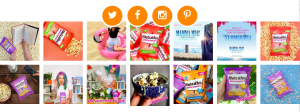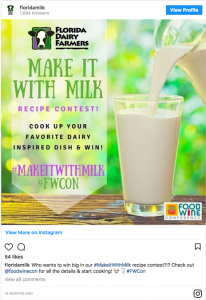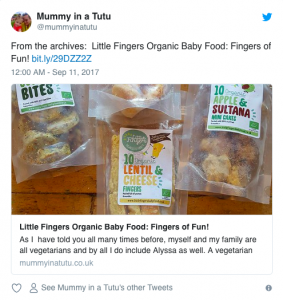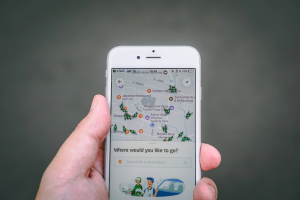Ecommerce Strategy for Food & Drink Shopify Stores
Standing out in the ecommerce space as a food or drink store can be a daunting challenge – but also a hugely exciting one.
While earning a space on the shelves of leading supermarkets is still a fiercely competitive business, creating a strong digital strategy for your brand allows you the freedom and the opportunity to become more visible to your ideal audience, build positive relationships with your customers and sell your products to buyers directly.
Written By
Esther Lowde

Yet in an industry which is becoming ever more saturated and competitive, how do you go about building a digital strategy that is strong enough to get your brand noticed and help you reach all of your business goals?
To help get you started, we’ve put together our top 10 tips for creating a digital strategy that is sure to level up your Shopify store’s ecommerce game:
1. Start by Identifying the Audience You Want to Attract

Gaining an awareness of your buyers’ purchasing habits and on-site behaviour will give you powerful insight into the steps you should be taking to optimise your digital strategy for success. All strong ecommerce planning should therefore begin with an analysis of exactly what kind of customers you are attracting to your store and what actions they are taking on your web pages.
Start by using heatmapping technology, customer surveys and your existing Google Analytics data to create a customer profile based on your buyers’ typical interests, local area, gender and age range.
You should also take note of what type of content is working best to engage your existing customers by monitoring which of your posts and products are generating the most engagement among your current website visitors, and by doing some research into the specific keywords and phrases that your customer base are searching for on Google.
Also look at data regarding which social media channels are generating the highest-spending traffic for you, as well as identifying which other marketing efforts draw in the most traffic to your site.
This information will help you tailor your digital marketing strategy to the right client in the right way on the right channels, meaning higher levels of customer engagement and faster traffic growth for you.
So, while you follow the below steps, always keep your audience profile in mind to help you decide what would best appeal to your unique customer base.
2. Showcase Professional Imagery of Your Products on Your Website
In today’s highly visual world of ecommerce design, strong product imagery should always be at the forefront of your customers’ shopping experience.
Using high-resolution product imagery is especially important for consumables stores as you want to convince your customers that your products are appetising and delicious – and that you are confident in showing them off to your buyers.
One study by Visual Website Optimizer found that larger product images increase sales by 9%, meaning your product images should be unmissable and the focus of every page.
Above all, make sure that all of the photos featured on your store are clear, attention-grabbing and present your consumable goods in the best light possible.
As an example of an effective and product-focussed online aesthetic, this website we designed for plant-based smoothie client FRAW draws customers in with vibrant images of fresh fruit, sleek and vibrant packaging, of smoothies being blended in a clean environment and finally of customers drinking and enjoying the finished products.
FRAW’s appetising and colourful product-focussed homepage imagery.
3. Feature Product Reviews on Your Shopify Store

As our recent article on the importance of user-generated content demonstrated, product reviews are major customer trust and conversion rate boosters for ecommerce stores of every kind – with multiple studies revealing that featuring them on your ecommerce store produces an 18% uplift in sales on average!
Displaying customer testimonials online is especially important for food and drink brands, as 93% of grocery shoppers state that they read product reviews at least occasionally and 34% claim to read them on a regular basis, a study by PowerReviews found.
The popularity of customer reviews on food and drink stores is due to customers’ desire to feel totally certain that the products they are purchasing for consumption are tasty, high quality and completely safe to eat or drink. Including customer reviews from previous happy buyers on your product pages is perhaps the easiest way to get your customers to trust that this is most definitely the case.
In terms of the apps we recommend for text-based customer reviews, Stamped is one of our favourites as it is simple and inexpensive but highly effective and a perfect fit for most Shopify food and drink stores.
4. Make Your Delivery Process as Simple and Affordable as Possible
With so many online grocery stores offering free and next-day delivery services, customers have come to expect rapid food and drink delivery at lower prices than ever – and may actually leave your website if there are no fast, cheap delivery options available on your ecommerce store.
In fact, same-day delivery options have been recently proven to encourage 72% of UK customers to shop more online. The pricing of your delivery options is just as crucial, with shipping platform Temando recently discovering that 6 out of 10 UK shoppers would order more goods from an ecommerce store if free shipping was offered.
While you may feel that this sounds like a lot to have to offer, especially for smaller businesses, it is still well worth thinking about what options you are able to offer potential customers in the way of more convenient delivery.
For example, introducing same-day delivery for shoppers with inner city postcodes, allowing free shipping after a certain amount of money has been spent or specifying time-slot deliveries for busy buyers would all work as highly effective promotional tools for your brand and increase the likelihood of your customers making purchases from your store.
5. Consider Setting Up a Subscription Service

Alongside speedy delivery, introducing a subscription service to your food or drink store has also proven to be a great way to increase your customers’ loyalty and satisfaction and to ultimately drive more sales.
Growth Business reports that around 90% of the British adult population are currently subscribed to their favourite stores, brands and services, demonstrating that the subscription business model is becoming increasingly popular with customers online – especially when they are offered the opportunity to ‘subscribe and save’ and receive a discount on your products in exchange for their loyalty.
However, there is no one-size-fits-all package deal when it comes to providing the best subscription service possible for buyers of your food and drink products. As your customers’ specific tastes may vary, investing in a custom subscription solution is a great way of upping allowing your customers to choose exactly the products that they would like delivered to their door.
One example of this is the personalised subscription management solution our Swanky developers created for meal delivery service Pasta Evangelists, which has helped to simplify the brand’s internal business management at the same time as making their recipe kits easier for their customers to select and order.
Pasta Evangelists’ bespoke meal selection page for new subscribers.
6. Host Online Competitions and Giveaways to Further Engage Your Customers
Inspiring your customers to experiment with your products on social media via hashtag campaigns and contests can work wonders in terms of enhancing your customers’ relationship with your brand – and is also one of the most effective forms of advertising you could possibly use to market your store.
In fact, 77% of customers state that they are more influenced by authentic customer-focussed photos when shopping than they are by professional campaign images, meaning that seeing others endorsing your brand and enjoying your delicious products while participating in your online competition is guaranteed to increase new buyers’ trust in the credibility of your business.
You could even incorporate a social feed into your website’s homepage to showcase your customers’ hashtagged Tweets, photos and Instagram posts for your store’s new visitors and make the most of your new marketing material.

Example of an integrated social feed on the homepage of one of our previous clients; Metcalfe’s Skinny.
Running a hashtag competition is also a good opportunity for your food or drink company to get creative and think of the type of contests that would engage your customer demographic best:
- Would your customers like to see new recipe ideas using your products?
- Might they appreciate the chance to submit a new design for your delivery boxes?
- Or would they be interested in coming up with a new winning flavour that you can then introduce to your next product range?
One great example of a successful hashtag contest is this competition hosted by Florida Dairy Farmers, who celebrated National Dairy Month by asking their followers to send in their favourite dairy-inspired dishes along with the hashtag #MakeItWithMilk:

After receiving over 600 entries from their customers, the brand featured their top 4 submissions from the month on their website, and gifted the Grand Prize winner a year’s supply of their milk, a branded gift basket and an evening at a professional cooking school.
This incentive motivated more users than ever to engage with the brand and spread the word about their products, increasing the credibility and likability of the dairy company among its customers and therefore positively impacting their sales.
7. Launch a Customer Loyalty Program

Attracting new customers to your store is a core part of any good ecommerce strategy, but don’t forget that it is just as crucial to nurture your relationship with your existing loyal customers.
In fact, studies show that just a 5% increase in customer loyalty can increase the average profit per customer by 25-100% (!), making rewarding your buyers for their continual engagement with your brand undoubtedly one of the best ways to boost your business’ sales.
In terms of recommended apps, our technology partners Loyalty Lion are our personal favourites as their program works seamlessly on all devices to reward customers for their purchases, product reviews, newsletter sign-ups and product recommendations.
Investing in a service like this is well worth your time if you are looking to sustainably increase your conversion rate, customer retention and the lifetime value of your customers.
8. Build Relationships with Industry Influencers

Are you a health food company? An indulgent chocolate brand? Do you sell beers in all kinds of innovative flavours?
Whatever your specialty may be, you can be sure that there are an abundance of food bloggers and online influencers who would love to test out, review and promote your products on their social spaces – along with thousands of their online followers who are all eager to try out the products their favourite influencers recommend.
Making the most of influencer marketing is one of the best ways to increase the appeal of your products to customers as it enables you to establish credibility and a strong reputation as a company.
In fact, studies show that 92% of consumers trust recommendations from others over branded content.
This means that reaching out to reputable food bloggers and asking them to review your products is an even more effective way of marketing your food or drink store than creating your own advertisements, making forming relationships with industry influencers an opportunity you do not want to let pass you by.

Example of parenting-focussed blogger Mummy in a Tutu reviewing an organic baby food brand and sharing her recommendation with her 15,000 followers on Twitter.
9. Display Product Prices in Your Customers’ Local Currency
Over the last few years, international ecommerce trade has become more popular – and more expected by customers – than ever before.
In fact, studies show that 13% of online shoppers who leave ecommerce websites without making a purchase have done so because the product prices were displayed in a foreign currency – and that 64% of consumers now regularly shop cross-border.
If you are interested in making the most of this opportunity and maximising your sales by tapping into the global market, you need to consider how you can make your online store as accessible and appealing as possible to your international customers.
While Shopify is currently rather limited in terms of its internationalisation options, the platform does have plans to roll out a new multi-currency function which will begin by supporting sales in 9 major local currencies, as well as a Local Payment Methods feature which will give international customers the option to check out using the local payment method that they are most familiar with.
We recommend making the most of these exciting new features as soon as they launch, as they are a fantastic opportunity to build your reputation and trust among a wider customer base and therefore boost your brand’s profitability on a larger scale.
However, if you are looking for a quick present-day fix before the launch of this new Shopify functionality, plenty of options still remain open to you.
For example, our web design team at Swanky have also created some bespoke multi-cart and multi-currency solutions to help existing Shopify stores reach out to a wider customer base by allowing shoppers to browse and check out in their local currency using their preferred method of payment.
Example of the multi-currency price display options we designed for our client StylTom’s ecommerce store.
10. Include a Store Locator on Your Homepage
Lastly, if you have a brick-and-mortar store which people can visit to see or sample your food or drink products for themselves, be sure to display it somewhere very visible on your website to let your customers find you as easily as possible.
It is also well worth listing larger multi-brand stores and vendors which stock your products as showcasing well-known logos can further increase potential customers’ trust in your brand.
The store locator and vendor logo display page our web design team created for sustainable sauce brand Rubies in the Rubble.
It’s time to get started!
Having considered all of these tactics for creating a successful digital strategy, you should be more than ready to get started with identifying, reaching out to and engaging with your ideal customer pool.
Remember that a good digital strategy is a continual and looping process. The more you interact with your customers, the more you will learn about the people who are buying your products – and the better you can market to them specifically.
After following your unique recipe for ecommerce success, you can enjoy the benefits of an increased following and faster revenue growth, watching your online food and drink store gradually rise to the place you have always wanted it to be.
Looking to outsource your digital marketing strategy and/or management?
If so, please feel free to get in touch with our friendly team of digital experts at Swanky for a chat about how we could help your online food and drink store maximise its revenue and increase its existing customer base.



